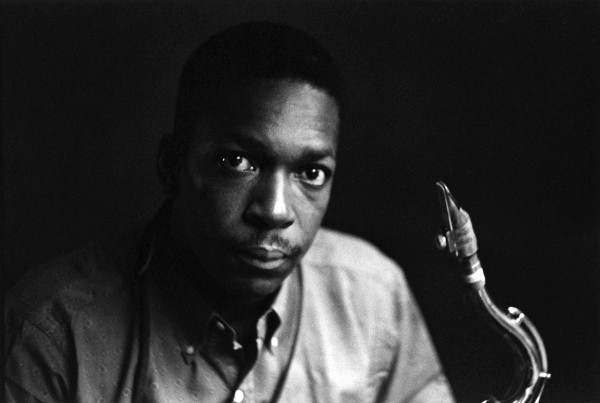Dec 9, 2025 12:28 PM
In Memoriam: Gordon Goodwin, 1954–2025
Gordon Goodwin, an award-winning saxophonist, pianist, bandleader, composer and arranger, died Dec. 8 in Los Angeles.…

In 1958, John Coltrane turned 32. He’d just rejoined Miles Davis’ band after a sojourn with Thelonious Monk, and had in the previous year finally freed himself of his addiction to drugs and alcohol.
(Photo: Esmond Edwards/CTSIMAGES)Perhaps the most striking thing about the current resurgence of interest in John Coltrane is the extent to which it focuses not on masterworks, but on transitional stages of the saxophonist’s development.
Some of that’s a result of the recently discovered material on Both Directions At Once, which suggested that the radical innovations of Coltrane’s later work already had taken root by 1963. And when the compilation 1963: New Directions placed those lost tracks alongside the other recordings he made for Impulse! that year—the lyric balladry of “They Say It’s Wonderful” with Johnny Hartman, the harmonic adventurism of “Dear Old Stockholm” and the prayer-like hush of “Alabama”—it was easier to recognize the individual strands that, once woven together, would form the fabric of 1964’s A Love Supreme.
Just as 1963: New Directions illuminates a critical phase of Coltrane’s musical quest, the eight-LP set Coltrane ’58: The Prestige Recordings captures him at a pivotal point in becoming one of jazz’s most influential leaders and soloists.
Coltrane turned 32 in 1958. He’d just rejoined Miles Davis’ band after a sojourn with Thelonious Monk, and had in the previous year finally freed himself of his addiction to drugs and alcohol. Having risen from the ranks of the promising to the realm of the prominent, he was in almost constant demand; the seven sessions he cut as a leader for Prestige were but a fraction of the 20 recording dates on his calendar that year (including five for Columbia with Davis’ band). Coltrane was just a year away from recording both Kind Of Blue and Giant Steps, and at its best, Coltrane ’58 provides a sense of how the saxophonist managed that particular ascension.
Notably, 1958 also was the year the late Ira Gittler, writing in DownBeat, coined the phrase “sheets of sound” to describe the torrents of notes the saxophonist would unleash as he tried to cram all the discoveries he gleaned from chord stacking into just a couple beats. Coltrane ’58 includes one of the most famous examples of this, the saxophonist’s fevered, double-time take on Irving Berlin’s ballad “Russian Lullaby.” But the set’s real treat is a transcription of his solo on the “Night Train”-ish blues “By The Numbers,” which makes visible the rhythmic variety of Trane’s fleet-fingered runs.
Given that he didn’t have a working band of his own at the time, a certain inconsistency of tone might be expected, but there only are a few moments across these 37 tracks where the music loses its focus. Even then, it’s only momentary, as on “I’m A Dreamer (Aren’t We All),” where, after trumpeter Wilbur Harden audibly falters, Coltrane charges in with a statement aggressive enough to lift to the band’s energy and make the silences in Harden’s solo seem like an intentional contrast. It helped that four of the seven sessions here were cut using Red Garland’s trio, with bassist Paul Chambers and drummer Art Taylor, as Coltrane knew Garland and Chambers from Davis’ quintet, and had a tremendously simpatico relationship with both. But apart from the leader, Chambers was perhaps the most valuable player here, turning up on all but one track and providing the sort of rhythmically reliant, harmonically incisive grounding Coltrane needed to concoct his own questing solos.
Chambers’ sound is also a useful yardstick for rating the audio quality of Craft’s remastering on these sessions. Although the original recordings, made by Rudy Van Gelder at his famous Hackensack, New Jersey, studio, long have been prized for their clear, uncluttered sound, there’s an element of transparency in Paul Blakemore’s remastering that the CD versions on Prestige lack. Listen to “I See Your Face Before Me,” the first stereo track on the set, and the improvements are immediately obvious; the soundstage is so well defined that listeners almost can point to where Chambers was standing, while his tone is deep, rich and natural, particularly on the arco solo, offering a strong, resonant sound, instead of the CD’s resiny rasp. Close your eyes, and you might imagine yourself on the sofa in Van Gelder’s living room, listening intently as Coltrane and company conjure a vision of jazz’s future. DB

Goodwin was one of the most acclaimed, successful and influential jazz musicians of his generation.
Dec 9, 2025 12:28 PM
Gordon Goodwin, an award-winning saxophonist, pianist, bandleader, composer and arranger, died Dec. 8 in Los Angeles.…

Nov 13, 2025 10:00 AM
For results of DownBeat’s 90th Annual Readers Poll, complete with feature articles from our December 2025 issue,…

Flea has returned to his first instrument — the trumpet — and assembled a dream band of jazz musicians to record a new album.
Dec 2, 2025 2:01 AM
After a nearly five-decade career as one of his generation’s defining rock bassists, Flea has returned to his first…

To see the complete list of nominations for the 2026 Grammy Awards, go to grammy.com.
Nov 11, 2025 12:35 PM
The nominations for the 2026 Grammy Awards are in, with plenty to smile about for the worlds of jazz, blues and beyond.…

Drummond was cherished by generations of mainstream jazz listeners and bandleaders for his authoritative tonal presence, a defining quality of his style most apparent when he played his instrument unamplified.
Nov 4, 2025 11:39 AM
Ray Drummond, a first-call bassist who appeared on hundreds of albums as a sideman for some of the top names in jazz…